3 keys to an effective welcome email
If you don’t send a newsletter subscriber a Welcome email, you’re making it harder to build loyal audiences right from the get-go.
In my original analysis of 99 Newsletters, not quite half the 99 Newsletters sent me a Welcome email.
Only 48% of senders in the 99 Newsletter Project sent a welcome email
Welcome Emails benefit from open rates 2-3x your regular emails. If you don’t send a newsletter subscriber a Welcome Email, you’re making it harder to build loyalty right from the get-go.
Why Welcome Emails are important
Your Welcome Email is your opportunity to roll out the red carpet for your new subscribers. Perhaps they have heard of you, but this is your chance to make the right first impression.
Experian research showed a 57.8% open rate for welcome emails. That’s 4x the open rate for other emails in the study. (Source: PDF link, 16 pages).
The 99 Newsletter Project welcome email has a 77.6% open rate as I write this.
What’s the open rate on your main newsletter? Somewhere around 20-30%?
Mailchimp says 22% is average for media and publishing.
Think about the last time you started a new job. You’re excited, but probably a little nervous. You clicked with the people in the interviews, but there’s still a leap of faith involved.
The best companies roll out a red carpet for you on the very first day. When you show up, you know exactly where to go. Your login credentials work. HR emailed you the paperwork you need to sign so you can bring it with you on the first day.
Maybe there’s a notebook or stationery on your desk. “Welcome to [your new job]. We’re glad to have you here,” it says. Handwritten.
You think to yourself, “Wow, they really have it together. I can’t wait to get started”.
That’s how a great Welcome Email should make a reader feel, so let’s get started!
3 keys to a great Welcome Email
- Be human.
- Put the reader first.
- Keep it brief.
1. Be human.
Nobody likes being treated as a nameless, faceless record in a database. Just because technology makes things easier doesn’t mean you need to turn into a robot.
Think about how many impersonal emails you send straight to the archive folder. You don’t even have to open them to know what they are. Do you like those? Do you want more of those? No way! Neither does anyone else.
Let your new subscriber know you aren’t one of those obnoxious email senders. Above all, let them know they made the right decision.
ProPublica Illinois sets clear expectations
The less conventional or traditional your newsletter is, the more important this is. Logan Jaffe of ProPublica Illinois has one of my favorite welcome email subject lines: “Welcome. Now let’s set some expectations.”
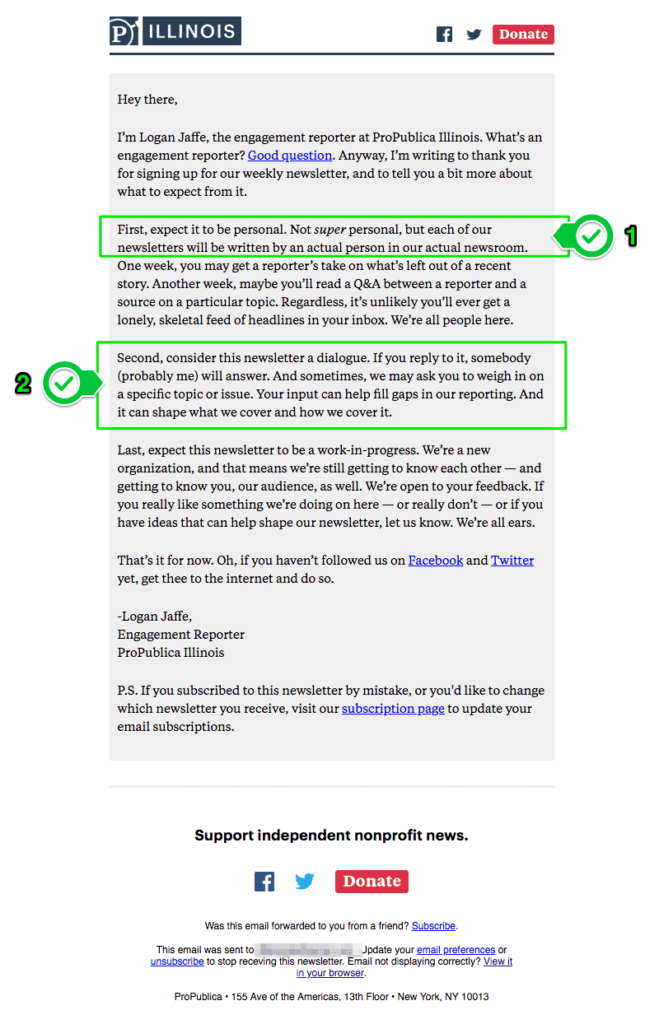
In this email, Logan lets you know that you will receive a newsletter each week, and (1) it’s written by a real person. This newsletter won’t be “a lonely, skeletal feed of headlines in your inbox. We’re all people here.”
Secondly, if you – an actual person – reply to this Welcome Email, (2) an actual person from ProPublica Illinois will read it and reply. They want to hear from you, they aren’t just broadcasting at you. This is important. If you want to build a relationship, you’re gonna have to give. These small messages are more than courtesy. The value accumulates over time. As an added bonus, Logan also adds the subscription page link to the P.S. section of the newsletter. The P.S. section is often a very valuable piece of newsletter real estate, but we’ll talk about that later.
2. Put the reader first.
Give ’em something special
Sarah Baker Hansen’s Welcome Email from Omaha Dines (Omaha World-Herald) is a great example of putting the reader first. Check this out:
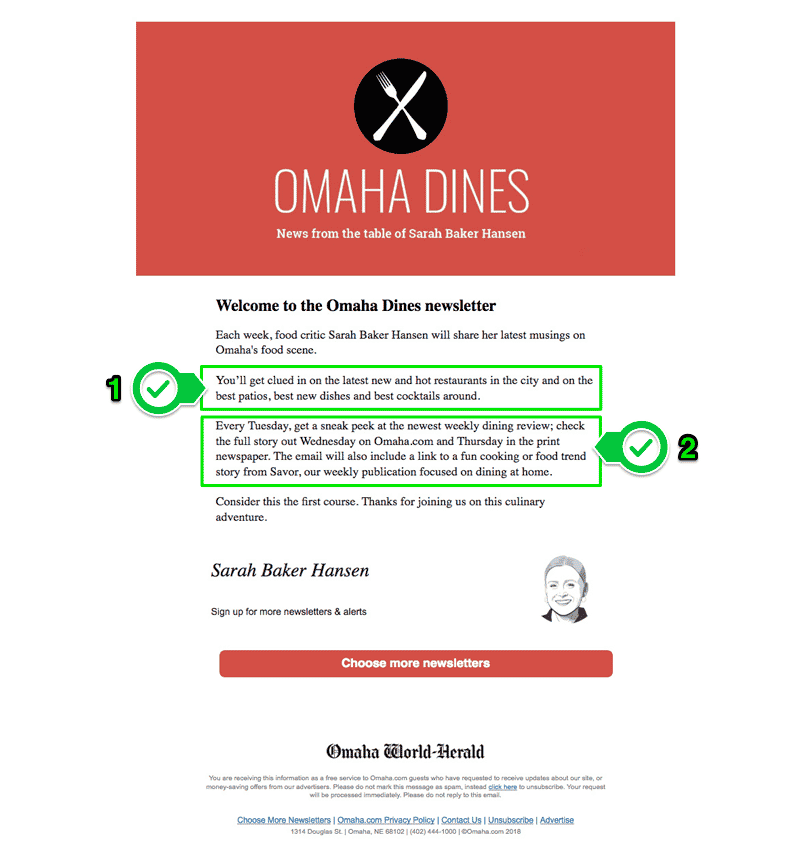
This email shows, it doesn’t just tell. It’s focused on what you, the reader, are getting out of this free newsletter. Let’s look at it closely: (1) “You’ll get clued in on the latest new and hot restaurants in the city and on the best patios, best new dishes and best cocktails around”.
That’s specific, relevant, and useful. It’s much better than something like “We cover the local restaurant and bar scene”. That’s not specific enough, and the value isn’t immediately obvious to the reader.
Second, you get a special bonus. You are a person who likes to be in the know when it comes to the Omaha food scene. Sarah is going to give you a (2) “sneak peek at the newest weekly dining review” before it’s online or in print.
But wait, there’s more! You’ll also get a story from the weekly home cooking magazine. All in one handy newsletter you can read on your phone. That’s all a hell of a deal for…free.
It’s really that simple. You have great work to share. Instead of saying “we cover all the restaurants and bars in Omaha”, dig one level deeper. Think about why people read these stories, and what they do after they read them.
Positive feelings lead to loyalty
Getting something special makes people feel good. Barbara Fredrickson, Ph.D., a research psychologist and Senior Scientist for Gallup, has done extensive work exploring positive emotions. Barbara Fredrickson, Ph.D., a research psychologist and Senior Scientist for Gallup has done extensive work on positive emotions.
If people feel grateful for your services, then that is the first step toward creating loyalty and engagement. In fact, I’ve done a lot of reading about gratitude. Theorists talk about how one way of repaying gratitude is with loyalty. And if you can harness that and find ways to make people feel grateful for what you’ve done for them, they’re more likely to repay you with loyalty.
How awesome is that?
Here’s how to get started crafting impactful, reader-focused email: Think about what your most enthusiastic fans and supporters absolutely love about you. Look at feedback emails and survey comments. Use their words as guidance. You want to find more people like them.
Additionally, say thank you! When you show gratitude, people perceive you differently. Researchers in Australia found saying “thank you” helps develop new relationships.
“The university students who were thanked were more likely to provide their contact details, such as their phone number or email address, for the mentee than those who were not thanked. The grateful mentees were also rated as having significantly warmer personalities. The results suggest that the reason why people ‘find’ grateful others is because of this perceived warmth.”
– University of New South Wales Sydney news release
These small messages are more than courtesy. The value builds over time. That is to say, the path to loyal and engaged audiences is a long-term investment.
Remind people when you will email them
This is crucial if it’s not a daily newsletter. Even if it is, I say remind them anyway. People have bills and kids’ birthday parties and brunch plans. They forget things. Repetition is important.
But what if you don’t publish on a traditional schedule? Check this out from Natasha Del Toro and Lance Dixon with The New Tropic in Miami:
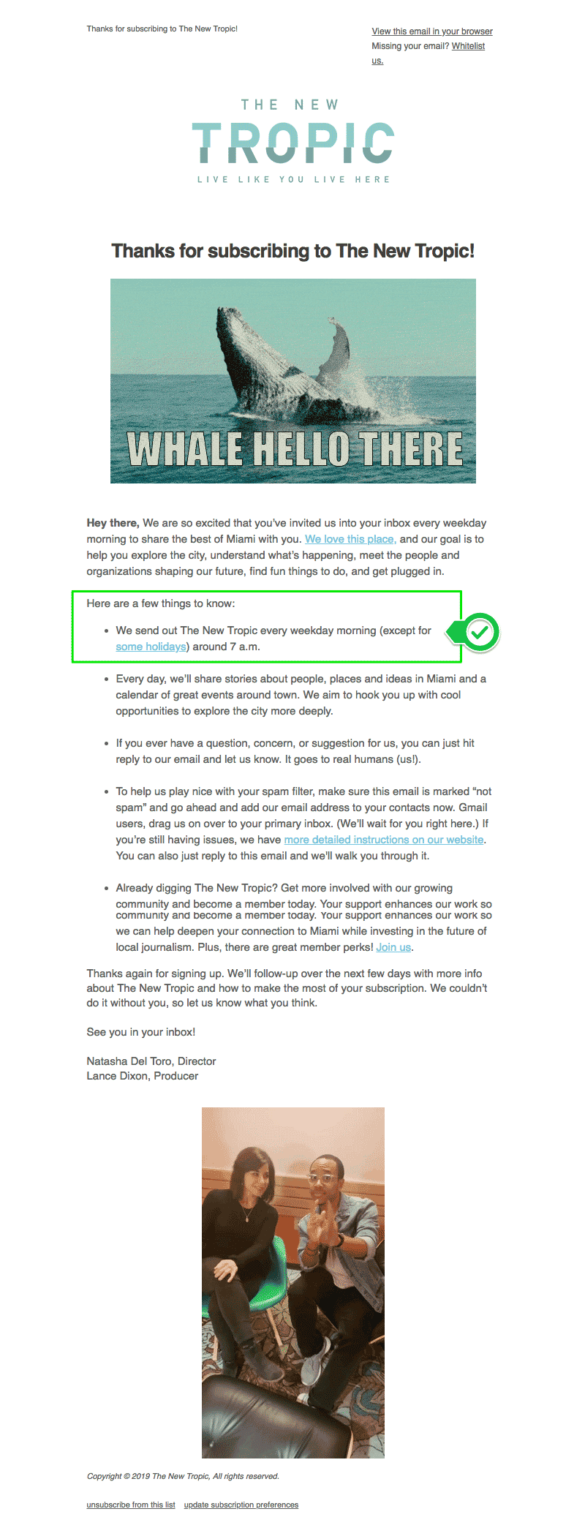
“We send out The New Tropic every weekday morning (except for some holidays) around a.m.”
Right there in the first bullet. They even link to the holidays! You know your inverted pyramid. Give your new subscribers the most important piece of information first.
What if you don’t publish on a traditional schedule? Here’s Lorie Hearn with inewsource.org in San Diego:
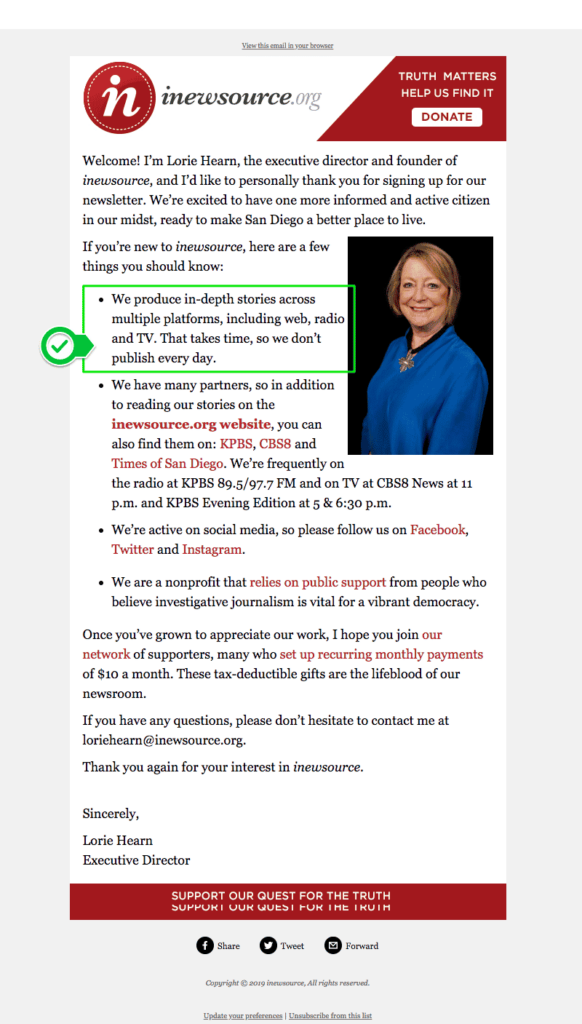
“We produce in-depth stories across multiple platforms including web, radio, and TV. That takes time, so we don’t publish every day.”
This is another example of setting expectations. inewsource is telling you upfront that you will hear from them when they have something important updates. You won’t get an email every day.
This schedule won’t work for every newsletter. It depends on your goals and your audiences, so be prepared to do the research and testing to back up your ideas.
Testimonials
Shelterforce Weekly is the all-star here. There are three testimonials from people raving about how valuable this newsletter is. This is a smart move, and I think more newsrooms should try it.
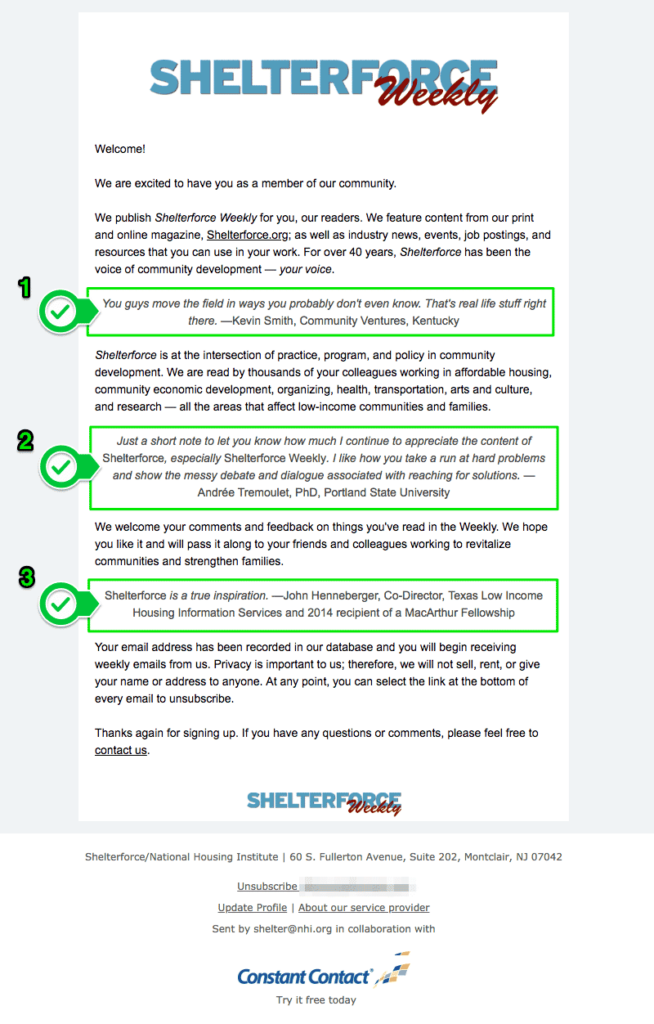
How awesome is that?
Here’s how to get started pivoting to reader-focused emails: Think about what your most enthusiastic fans and supporters absolutely love about you. Look at feedback emails and survey comments. Use their words as guidance. You want to find more people like them.
3. Keep it brief.
Don’t overwhelm your new subscriber. Hold a little back. Don’t be pushy. Allow your new subscriber time to get to know you.
I know you are excited to show them what great work you do. You will get that opportunity. Trust me.
You have this person’s email address and attention. Rather than sending them one jam-packed email covering everything from the history of your organization to how to give you money to all your social links to all your top stories — take a breath.
Let’s write a great new welcome email together with this free template
I love email newsletters because they’re great at turning casual readers into loyal readers. The very best newsletters are useful, relevant, and anticipated. If you can do those three things, your readers are on the right path to building their habit.
Additionally, the more you are able to focus newsletter value on your audience, the more your revenue will grow. Welcome emails are the first step to doing that.
Download this free Welcome Email template
Google Doc Template
Click to open the Doc template in a new window
PDF Template
Click to open the PDF template in a new window
This template is a starting point. Will it be the first Welcome Email to win a Pulitzer? I sure hope so (but probably not).
What it will do is give your readers additional reasons to be interested in future issues of your newsletter. That’s going to help you build loyal readers and capture more of that reader revenue that will take you to the next level.
Send emails from a real person
Trust is an important topic in journalism. You’re going to have a hard time getting people to trust you if you don’t treat them like a person from the outset. An easy way to earn your reader’s trust from the beginning is to make sure your first contact with them is from a real person at a real email address.
This reader gave you their email address and that’s valuable because it’s personal. Using “no-reply@localgazette.com” doesn’t feel personal, and doesn’t invite reader engagement.
Important tip: Set up a brand new email address for sending your newsletter. If your main email is awashington@localgazette.com, set up alexwashington@localgazette.com. If you use the same primary email used for one-to-one emails and mass mailings, you risk your personal emails going to someone’s promotions folder.
If you don’t want to attach your newsletter to one person’s name, try options like:
- hello@localgazette.com, used by New Tropic, InclinePGH, Tyler Loop, Denverite.
- Charlotte Agenda uses hi@charlotteagenda.com.
- reply@localgazette.com used by Rivard Report and NJ Spotlight. Not as personable as “hello”, but it suggests a person can reply to the email.
Using the name of the newsletter as the sender’s email also works. Examples include the food newsletter from Berkeleyside coming from nosh@berkeleyside.com and thebrief@texastribune.org from Texas Tribune.
If you choose one of these options, make sure to introduce the author or sign off with a real person’s name.
In my 2019 analysis of 99 Newsletters across the country, 56.6% sent emails from a real person.
Encourage people to reply to your Welcome Email
Only 34.8% of these Welcome Emails in the 2019 study encouraged people to reply directly to the email. I’m a proponent of encouraging people to reply because it has 3 meaningful benefits:
- It proves there’s a real person on the other end of the email.
- When people reply, it’s a signal to mailbox providers that you are trustworthy. That gives you a better shot of sliding into that Primary inbox rather than the spam folder.
- It conditions people to share feedback because they know someone is listening.
You never know when someone on the other end has valuable insight to share. Give them the opportunity!
For your swipe file: Tyler Loop
This Welcome Email from The Tyler Loop is a great example of a Welcome Email that hits all the right notes. I didn’t write it, but I’d be proud if I had.
Let’s look at each piece:
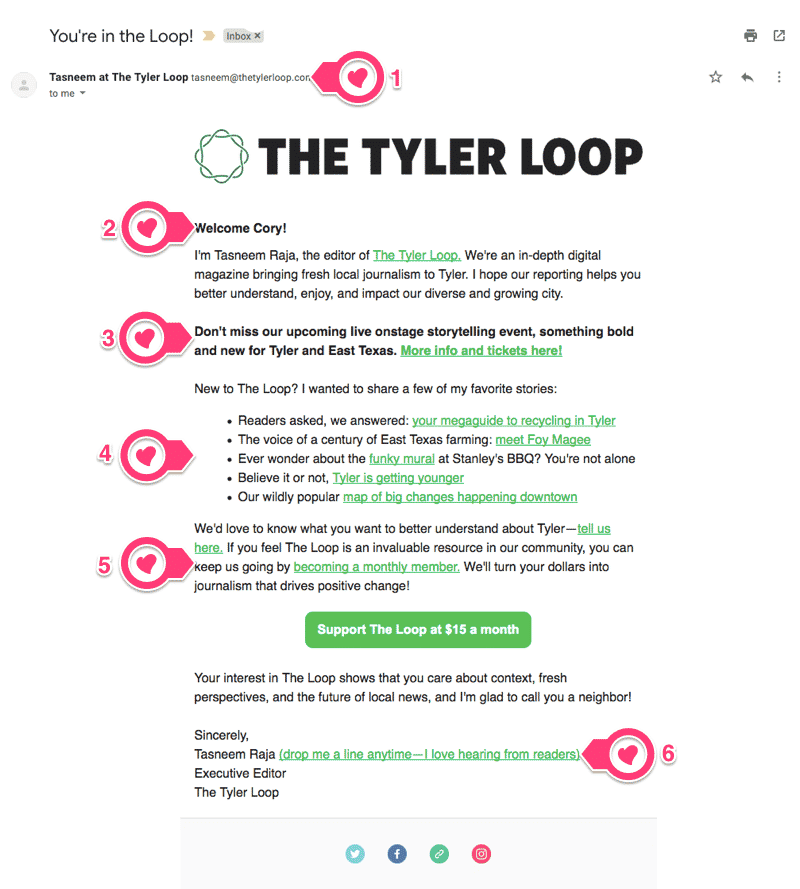
For starters, it’s from (1) Tasneem at The Tyler Loop, a real person. Real name and real email.
Next, we have (2) a personalized greeting. Nothing fancy, but a great way to kick off a relationship.
After the brief intro, we have (3) information on a live storytelling event, “something bold and new for Tyler and East Texas.” If you have events, don’t forget to invite people!
Then, Tasneem shares (4) of her favorite stories. Note the first one: “Readers asked, we answered.” This is an excellent way of putting the reader first.
Last but not least, the Tyler Loop will (5) “turn your dollars into journalism that drives positive change”. That’s something enticing to be a part of.
And maybe my favorite part, (6) in her signoff, Tasneem encourages readers to email: “drop me a line anytime – I love hearing from readers”.
That’s a great welcome email for new subscribers. Are you ready to write yours? You got this!
Write to a real person
Nobody likes to be treated like a chunk of data. An easy way to get around this is to write like you’re talking to one specific person.
Take a minute to visualize them. Why are they reading this? What gets them excited when they see your newsletter in their inbox?
Now, what’s a good greeting? Be friendly, but not too familiar. Hi. Hello. Thanks for subscribing. Welcome!
10 of the Welcome Emails (21.7%) I saw in the 99 newsletters started off with “Welcome new subscriber” or “Dear Reader”. That’s worse than no greeting at all because it feels like junk mail.
“Hey there” may be casual, but it’s not clunky and weird like “Dear Customer”. If “Hi there” is too casual for your tastes, try “Thank you for subscribing” or “Welcome”. Eleven newsletters used these greetings and they’re still a lot better than “Dear Reader”
If you can’t execute personalization, skip it.
Personalization is a great way to connect with your newsletter subscribers, but it’s harder to pull off than throwing merge fields in an email.
A lack of personalization is better than bad personalization, so if you can’t nail it, skip it. Broken personalization like “Dear *|FNAME|*” is the worst.
Shoutout to Chicago Reporter, Oklahoma Watch, Tyler Loop, and Wyofile! They each used personalization in their Welcome Emails.
A final tip about personalization: If you’re going to use use it, test it first to avoid the dreaded broken personalization. Thankfully, only 1 of the 99 Newsletters had broken personalization in the Welcome Email.
Keep it simple.
Start with a quick intro, but no more than a sentence or two. Keep your focus on the reader.
Here are some examples:
“I’m Scott Lewis, editor in chief and CEO of Voice of San Diego.”
“Welcome to the Forward. We are delighted that you’re making the Forward a daily habit.”
“Welcome to The Incline, a news organization for Pittsburghers who want to understand today’s issues to make tomorrow better.”
Put the important points at the top
This should be information like:
- How often you are going to email. Day & time is even better, especially if it isn’t daily. (54.3% of Welcome Emails did this in the 2019 study)
- How to update subscription preferences. (13%)
- Whitelist instructions. (13%)
How do you make sure you get the most useful points first? Start with those three, but ask around for any recurring problems you’ve had. If you can address those before they become problems, your new subscriber will thank you.
First things first
The Marshall Project does a great job of hitting three important points in five sentences:
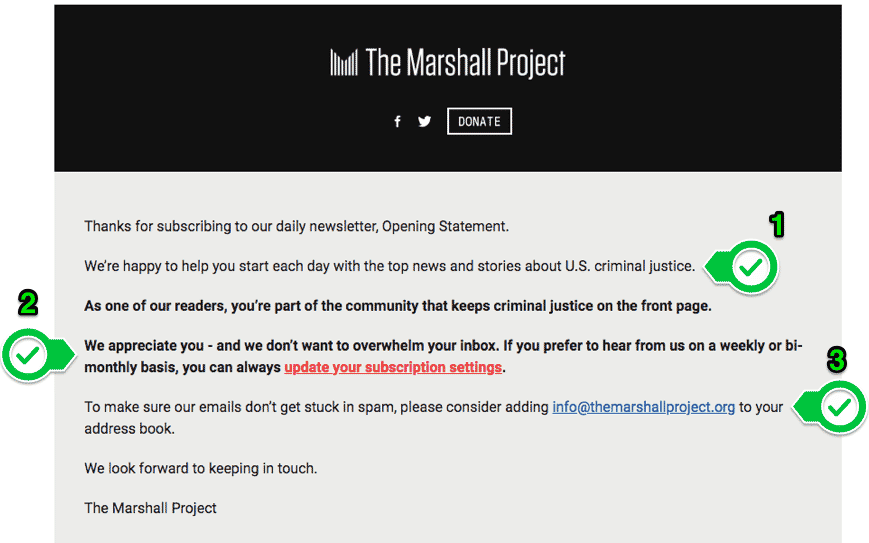
- How often you are going to email.
- How to update subscription preferences.
- Whitelist instructions.
Wrap it up (in a delightful bow)
Use the last paragraph to surprise or delight your new subscriber. To make this work, you must present benefits rather than features.
Here are a few examples. Pick one, or write your own:
Let ’em know if you’re a nonprofit
If you are a nonprofit newsroom, let people know. You don’t need a lengthy explanation, but people are still becoming aware of nonprofit newsrooms so help them identify yours.
It’s also a great time to mention donations are tax deductible or that your site has no advertising. These are both huge benefits to people!
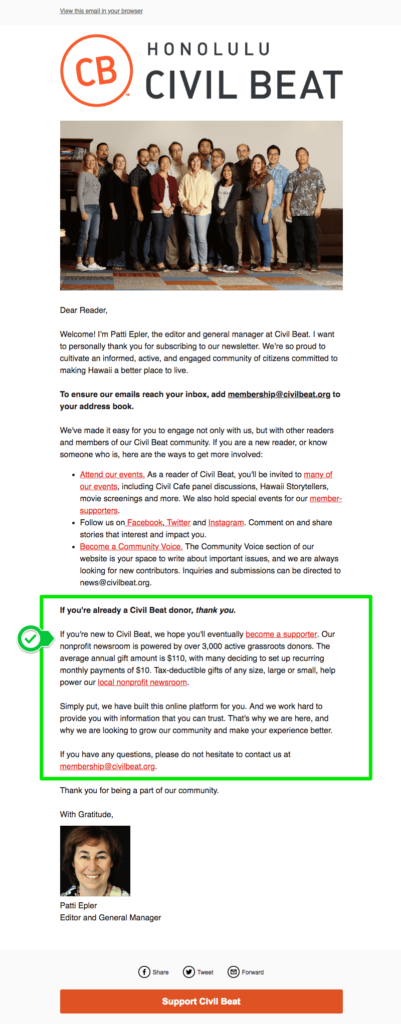
Take this from Patti Epler of Honolulu Civil Beat: “Our nonprofit newsroom is powered by over 3,000 active grassroots donors.” She goes on to mention the average gift, and that gifts are tax deductible.
If you have an established donor base, sharing your numbers is a nice way to show people they can be a part of something bigger.
Introduce your membership program
If you have a membership program, let people know. A lot of people out there aren’t familiar with membership programs run by newsrooms.
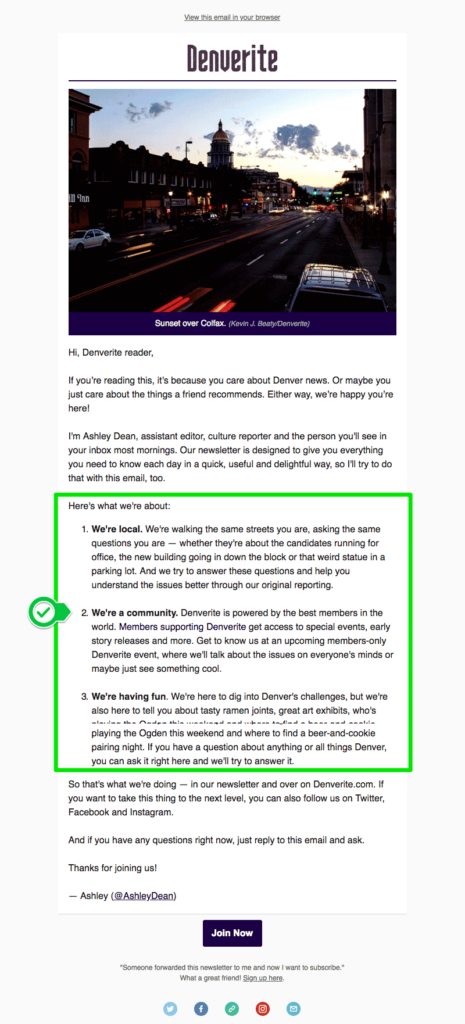
Ashley at Denverite lets new readers know that membership gets you access to “special events, early story releases and more”. This is a deeper, more rewarding subscriber relationship that many people realize is possible.
Promote your other newsletters!
It’s 2019, we can’t afford to silo some products from others. We’re in this together, so give people the opportunity to explore your other offerings.
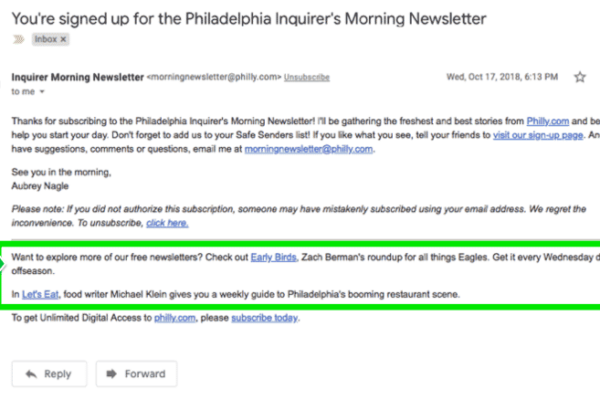
If you don’t have other newsletters, maybe share some links to recent top stories. Think about these though and don’t just grab the Top 5 with the most page views. What stories got the most feedback, or led to a big change in your community? Use this to demonstrate your impact.
Sign off
Thank you for reading,
Cory Brown
The 99 Newsletter Project
Something that easy.
Get more updates like this, and
unsubscribe anytime with no hassle
Featured image photo by Mario Calvo

